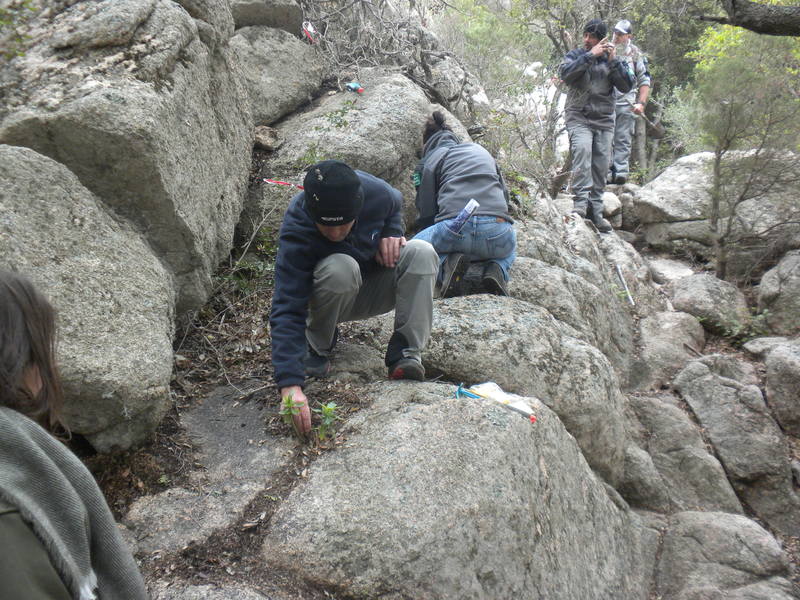- Home
- Chi siamo
- News
- Pubblicazioni
- Partners
- Gruppo Specialistico sulle Piante Mediterranee (IUCN / SSC)
- Fondazione Giardino Botanico di Sóller
- Conservatorio Botanico Nazionale della Regione Corsa
- Orto Botanico di Cagliari
- Università di Catania
- Istituto Agronomico Mediterraneo di Chania
- Istituto di Ricerca Agraria di Cipro
- Dipartimento Forestale di Cipro
- Outputs
- Contatti
Conservation Actions for Threatened Mediterranean Island Flora: ex situ and in situ joint actions
Strengthening the unique population of a strict endemic of Corsica: Centranthus trinervis
22 November 2017
The three-ribbed Centranthus (Centranthus trinervis (Viv.) Beg.) is a taxon of the Caprifoliaceae family (formerly Valerianaceae) whose unique population is found on the granitic massif of Trinité* (Municipality of Bonifacio).
This protected strict endemic that lives on the flats and in the fissures of the rock walls counted only 118 individuals at the last count of June 2016 (counting done by observation with binoculars from the foot of the massif and by climbers on ropes, thanks to the climbing team of the Regional Natural Park of Corsica (PNRC)). It is therefore extremely rare and was the subject of a national action plan (PNA) in 2012.
* The Sardinian populations, in the past regarded as C. trinervis, are well separated geographically and ecologically and have been distinguished under the name C. amazonum Fridl.


Inflorescence of C. trinervis and the massif of Trinité


C. trinervis habitat and population count, on ropes, with the climbing team of the PNRC
The three-ribbed Centranthus has suffered in the past years from the popular ‘fashion’ for nature sports such as rock climbing, but consultation actions with local stakeholders have allowed to eliminate the climbing equipment from walls and to protect the majority of the plant individuals. In addition, a big part of the site with the population of Centranthus was acquired by the Conservatoire du Littoral (Cdl); part of the area is classified as Natura 2000 site and it is managed by the team responsible for the natural reserve of “Bouches de Bonifacio” (RNBB). Despite the measures taken, the three-ribbed Centranthus is considered "endangered" (EN) because the population of Trinité, although stable for more than 15 years, is the only known population in the world. As a result, it is particularly vulnerable.
As part of the CARE-MEDIFLORA project, CBNC has carried out seed collections and ex situ cultivation of the taxon. The creation of a new population of Centranthus in a neighboring zone, presenting the same ecological conditions as the natural stand, was also planned for security reasons.
Before proceeding with the population reinforcement, an agreement was signed with the landowner; special authorizations to reinforce the population of the protected plant species were requested and obtained in November 2017 from Cdl and the Ministry.
The operation took place on November 15, 2017 with the team of the RNBB and those of the CBNC. Forty (40) 6-month-old seedlings and fifty (50) seeds were planted southwest of the natural stand, in rock crevices and on flats. A monthly monitoring will be carried out during the first year. Then an annual monitoring (every June) is considered to be enough.
Some of the plants produced (about 40) will be kept in the nursery for another year:
- to allow ex situ seed collection in June 2018, since the collection of seeds from the natural population (in situ) poses in fact several problems because of the difficulty to access the plants (photos 3, 4 and 5) and because of the fruiting process that is characterized by a very fast dispersion as soon as fruits reach maturity
- to carry out a new operation of population reinforcement in November 2018, which could profit from the results of one year monitoring of the first operation.

Operation for the reinforcement of the population of C. trinervis of Trinité











